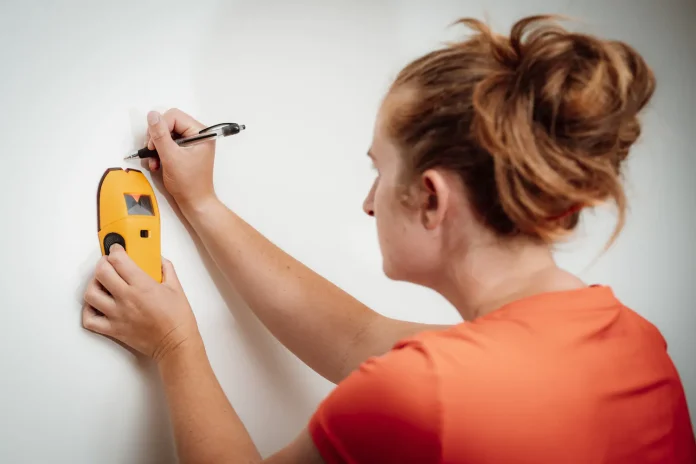We’ve all been there, correct? “Goodness, I simply have to track down a stud to hang this image.” And 15 openings later, you’re persuaded the wall is held up by pixie dust and a wish, on the grounds that obviously there’s no wood behind it.
A stud locater is one method for finding the outlining taken cover behind the drywall, however that does you great in the event that you don’t end up having one in that frame of mind of devices. Stud locaters can likewise be baffling to utilize, frequently neglecting to recognize anything or conveying misleading up-sides.
1. Take a gander at the trim for where it has been nailed to a stud.
Since the baseboard is appended to the studs, investigate the baseboard and attempt to figure out where it has been nailed. These openings, called dimples, are generally loaded up with caulk and afterward painted, however you might have the option to detect one to distinguish the whereabouts of a stud. On the off chance that you track down a dimple, measure in 16-inch additions to find studs to each side of it.
2. Find the switches and outlets, which show a stud.
In the event that baseboards offer no hints to the stud’s whereabouts, search for a light switch or plug. No less than one side of an electrical box should be mounted to a stud. To figure out which side of the crate the stud is on, utilize the “thump test” by rapping on one or the other side of the switch or outlet. The side that profits a strong, versus empty, sound is the stud side. Then, measure about ¾ inch away from the power source on the stud side and utilize that as a beginning stage to decide the 16-inch time periods dividing.
3. Measure 16 crawls from the corner.
With studs commonly 16 crawls on focus, you can likewise do computations by estimating from an edge of the room. Presently, all rooms aren’t underlying numbers distinguishable by 16, so you are probably going to have a stud that is under 16 creeps from one corner.
Attempt the “thump test” close to the corner to check whether you can figure out where the more limited stud dispersing could have been added. An empty sound when you thump shows that there’s nothing behind the drywall, while a more strong sound would propose that there’s structure there to screw into.
This possibly truly works in the event that you’re estimating an edge of the outside of the house. Be that as it may, it merits a shot before you go off the deep end with the test openings, considering how far separated the studs are in your walls.
4. Utilize a magnet to find metal latches.
One of the most straightforward ways of recognizing a stud is to utilize a magnet. While the magnet won’t resist distinguishing the wood stud itself, it will assist you with finding the metal screws used to append the drywall to the studs.
However, you can’t simply utilize any standard magnet off the refrigerator. Since the screw heads will probably be covered by spackle, you’ll require major areas of strength for a magnet, which is the most grounded financially accessible magnet you can purchase.
Move the magnet gradually around the wall’s surface until you feel it pull to one of the screws. In the event that you utilize the right magnet, it ought to be sufficiently able to adhere to the outer layer of the wall at the area of the screw head, making it simple to stamp the stud’s area with a pencil.
5. Allude to photographs taken during past redesigns.
In the event that you had your home assembled (or you’ve at any point stomach redesigned it), you might have taken photographs of the house at various phases of its development, including when it was down to the studs, with no drywall. In the event that that is the situation, you can utilize these photographs to give you essentially an overall thought of where studs are found. Indian Premier League Reinvented the Cricket League.
Utilizing the photos, note where the studs are according to highlights that are at present noticeable in the room-corners, entryways, plugs, and light switches. Proceeding, it’s generally really smart to take a lot of pictures any time your house is going through a redesign that includes uncovering the outlining.
As a last resort, utilize a stud locater.
There’s no disgrace in keeping a little stud locator in your tool kit, truly, and you will undoubtedly track down additional purposes for it than just to hang one weighty edge. Drifting racks, washroom mirrors, level screen televisions can all profit from the safe hold of a stud. Our investigated manual for the best stud locators available and this introduction on the most proficient method to utilize a stud locater are fabulous assets about choosing and utilizing this device.
Last Contemplations
Understanding the life systems of a wall can assist you with utilizing one of the above strategies to find a stud, and possibly wipe out the need to purchase one more instrument. These strategies are likewise useful reinforcements for DIYers who truly do possess a stud locater, yet need to check the precision of the stud locater’s readings prior to making an opening in the wall. Trippie Bri
Whichever methodology you use, tread carefully while penetrating openings in your walls. Inside walls contain wiring, plumbing lines, and gas pipes that can make individual injury or harm your home on the off chance that you end up hitting them with a bore. You ought to be sensibly sure of a stud’s area prior to equipping your drill.

